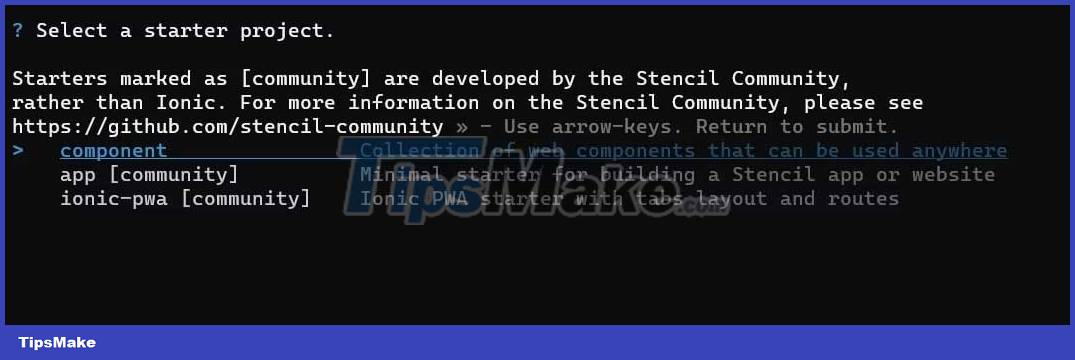How to build web components using Stencil.js
Stencil.js is a compiler that generates web components compatible with all modern browsers. Stencil.js provides tools and APIs that help you build fast, efficient, and scalable web components.

Stencil.js User Manual
First, you need to launch it on your computer. Do this by running the following command in the node.js terminal:
npm init stencilAfter running this command, a prompt will appear on the screen for you to choose the project you want to start:

To continue, click the component selection, enter the name of the project and confirm the selection:

Next, change the directory of the project and install the dependencies by running the following commands:
cd first-stencil-project npm installCreate a new web component
To create a new web component in Stencil.js, create a directory path like src/components. This components directory will contain a TypeScript file named after your element, because Stencil.js uses TypeScript and JSX to develop the component. This folder also contains a CSS file that contains the element's style.
For example, if you want to build a component named my-button, create a file named my-button.tsx and a CSS file named my-button.css. In the file my-button.tsx , define the element using the Stencil.js API:
import { Component, h } from '@stencil/core'; @Component({ tag: 'my-button', styleUrl: 'my-button.css', shadow: true, }) export class MyButton { render() { return ( ); } }This code imports Component and h from Stencil.js. The Component function identifies the element, and the h function creates its markup in HTML.
Define the component with @Component , which takes an object with 3 properties: tag , styleUrl , and shadow .
The tag attribute contains the tag name of the element. The styleUrl property defines the CSS file to style the custom element. Finally, the shadow property is a boolean, indicating whether the element will use the Shadow DOM to encapsulate the element's styles & operations. In the render method, create a button.
In addition to the styleUrl property , you can use more properties to style elements: style and styleUrls .
The style attribute defines the inline style for this element. It takes a string value representing the element's CSS style:
import { Component, h } from '@stencil/core'; @Component({ tag: 'my-button', style: ` button { padding: 1rem 0.5rem; border-radius: 12px; font-family: cursive; border: none; color: #e2e2e2; background-color: #333333; font-weight: bold; } `, shadow: true, }) export class MyButton { render() { return ( ); } }
The styleUrls property defines multiple files outside of the CSS for styling the element. It takes an array of string values representing the paths to the CSS file:
import { Component, h } from '@stencil/core'; @Component({ tag: 'my-button', styleUrls: ['my-button.css', 'another-button.css'], shadow: true, }) export class MyButton { render() { return ( ); } }Export web components
Once you've created the web element, you can export it to an HTML file by adding a custom element tag. Here's how you can include the my-button component:
Stencil Component Starter Overall, Stencil.js is a powerful, fast and efficient tool for creating web components. Hope the article helps you better understand how to use Stencil.js.
You should read it
- With these 5 tips will help you improve the logic programming ability
- These programming languages for the best mobile application development
- HTML test with answers - Part 2
- The development flow of programming languages, new problems that are not new
- Set of multiple choice questions about programming with P12
- Set of multiple choice questions for programming with P15 prize
- Set of multiple choice questions about programming with P10 prize
- Set of multiple choice questions about programming with P7 prize
May be interested
- How to choose a PC case
 the case may not be the most exciting component of your new build, but it's certainly important. the right case for your unique choice of components can make or break your overall pc experience.
the case may not be the most exciting component of your new build, but it's certainly important. the right case for your unique choice of components can make or break your overall pc experience. - How to build a small PC with Mini-ITX
 you want to build a new pc yourself, but don't have a lot of space and a little limited budget. so it's time to take a look at the mini-itx form factor.
you want to build a new pc yourself, but don't have a lot of space and a little limited budget. so it's time to take a look at the mini-itx form factor. - Microsoft released Windows 10 build 17074, providing operating systems with many new features
 this is microsoft's first windows 10 build in 2018 for the windows insider program released to users of the fast ring branch (including skip ahead). the windows 10 build 17074 version has many improvements to the operating system that are not inferior to the final build of 2017.
this is microsoft's first windows 10 build in 2018 for the windows insider program released to users of the fast ring branch (including skip ahead). the windows 10 build 17074 version has many improvements to the operating system that are not inferior to the final build of 2017. - 8 best PSUs of 2019
 a computer power supply unit or psu is the power supply source for all the other components of the system. therefore, choosing the right capacity and features to get the best performance is essential.
a computer power supply unit or psu is the power supply source for all the other components of the system. therefore, choosing the right capacity and features to get the best performance is essential. - Instructions on how to build a computer at home simply and quickly
 a detailed guide on how to build a home computer is simple and quick. building computers at home is not a simple matter if you do not have much experience.
a detailed guide on how to build a home computer is simple and quick. building computers at home is not a simple matter if you do not have much experience. - How to dress Senna DTCL season 2
 this is how to build senna dtcl season 2, because her role is only the main support, so it will include equipment to help support teammates and better combine the tribe.
this is how to build senna dtcl season 2, because her role is only the main support, so it will include equipment to help support teammates and better combine the tribe. - How ChatGPT helps build a cheap, powerful PC
 with an $800 budget and photo editing performance as a goal, try asking chatgpt for a list of recommended pc parts.
with an $800 budget and photo editing performance as a goal, try asking chatgpt for a list of recommended pc parts. - Microsoft Build 2017 2nd day: Although not a developer, you need to know these contents
 on the second day of microsoft build 2017, microsoft revealed many more practical features for most windows users, so it is much more desirable.
on the second day of microsoft build 2017, microsoft revealed many more practical features for most windows users, so it is much more desirable. - How to build the Nocturne lineup for the DTCL swordsmen season 2
 with the standard nocturne sword maker build in this article, you will have a true meat grinder when the damage of the squad if completed is very terrible.
with the standard nocturne sword maker build in this article, you will have a true meat grinder when the damage of the squad if completed is very terrible. - This young man uses a dishwasher to wash computer parts, if you're not sure, don't try
 not a good way to use it, but it turns out that knowing how to do it works.
not a good way to use it, but it turns out that knowing how to do it works.










 New highlights in Angular 16
New highlights in Angular 16 Benefits of using RESTful API
Benefits of using RESTful API How to Debug a Node.js Application in Visual Studio Code
How to Debug a Node.js Application in Visual Studio Code How to Build a GraphQL API with Apollo Server and MongoDB
How to Build a GraphQL API with Apollo Server and MongoDB CONCAT vs. TEXTJOIN: Which function should I choose to concatenate data?
CONCAT vs. TEXTJOIN: Which function should I choose to concatenate data? How to easily manage databases with phpMyAdmin
How to easily manage databases with phpMyAdmin